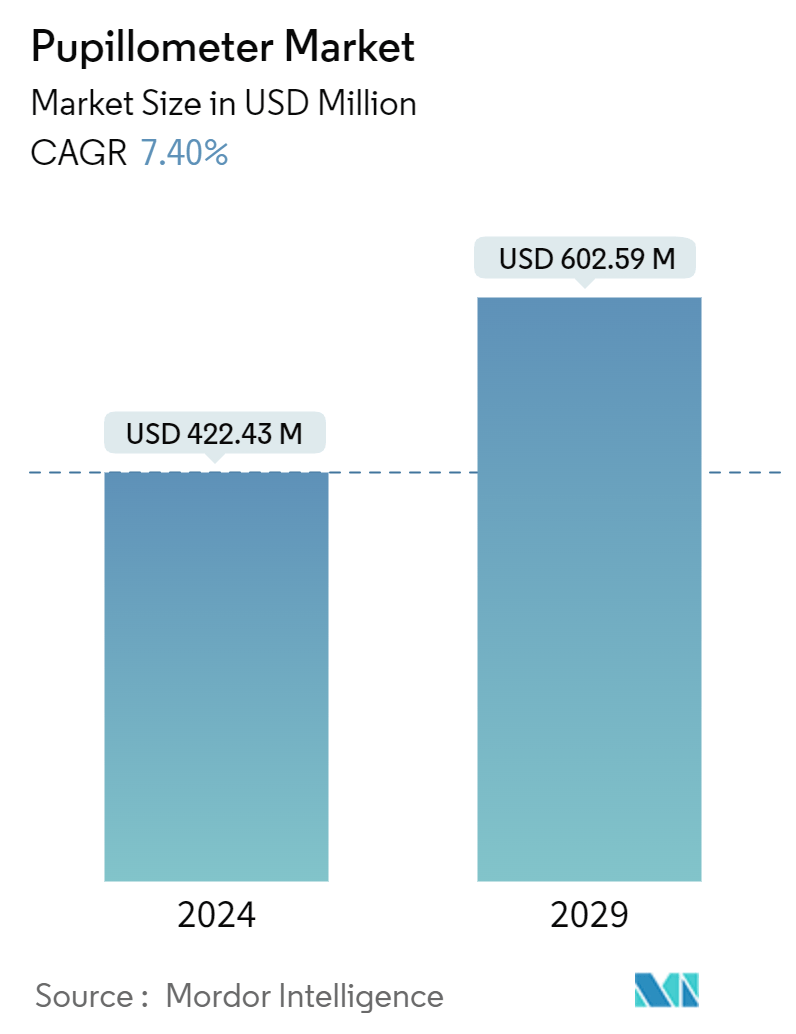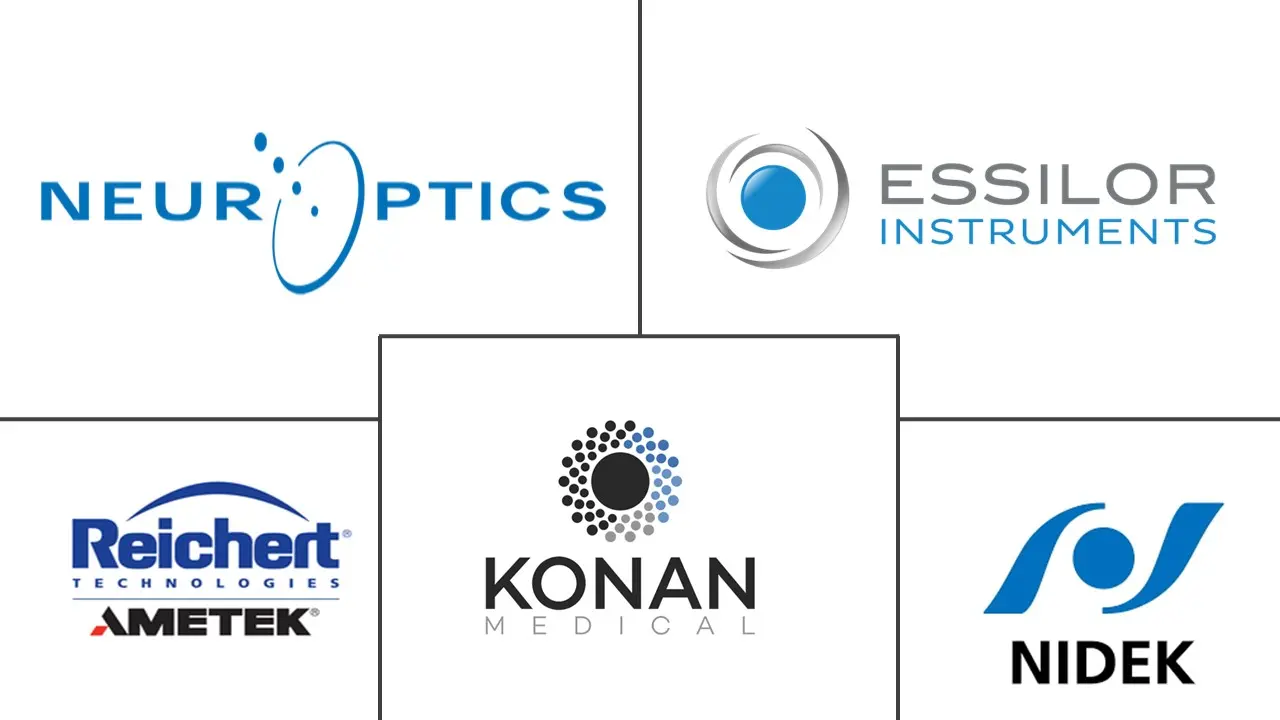Market Size of Pupillometer Industry

| Study Period | 2019 - 2029 |
| Market Size (2024) | USD 422.43 Million |
| Market Size (2029) | USD 602.59 Million |
| CAGR (2024 - 2029) | 7.40 % |
| Fastest Growing Market | Asia-Pacific |
| Largest Market | North America |
Major Players
*Disclaimer: Major Players sorted in no particular order |
Pupillometer Market Analysis
The Pupillometer Market size is estimated at USD 422.43 million in 2024, and is expected to reach USD 602.59 million by 2029, growing at a CAGR of 7.40% during the forecast period (2024-2029).
The major factor leading to the growth of the market studied includes the rise in awareness associated with pupillometers over manual pupillary examination, coupled with technological advancements. Other factors that contribute to the growth of the market include the surge in the prevalence of chronic disorders requiring the use of a pupillometer.
People suffering from depression, anxiety, Parkinson's disease, and autism spectrum disorder had abnormal pupillometry responses to stimuli. Pupillometry aids in understanding an individual's normal eye performance and brain activity disrupted by sickness. Hence, the growing burden of neurological diseases is expected to increase the screening rate and demand for pupilometers, thereby boosting market growth. For instance, according to the World Alzheimer's Report 2023, an estimated 6.7 million Americans aged 65 and older had Alzheimer’s in 2023. Seventy-three percent were aged 75 years or older. This disease led to an abnormal effect on the eye. The demand for pupillometers is likely to increase during the forecast period.
Afferent pupillary defect (APD) is a measure of asymmetry that may occur with the optic nerve, brain tumors, retinal or cerebral vascular disease, and amblyopia. It occurs specifically when the disease or disorder presents asymmetrically. Hence, a surge in the prevalence of diseases such as brain tumors leads to a rise in demand for pupillometers, which are used to detect APD in patients suffering from brain tumors. For instance, according to an estimate by the American Society of Clinical Oncology (ASCO), 25,050 adults were estimated to be diagnosed with primary cancerous tumors of the brain and spinal cord in the United States in 2022.
Over the years, manual pupil assessment has remained a major way of obtaining pupillary information about a patient. The various initiatives taken by private and public organizations to increase the adoption of pupillometer in developing and underdeveloped countries are expected to boost market growth during the forecast period. For instance, in February 2023, the SBI Foundation donated INR 1.41 crore (USD 0.16 million) to a charitable medical institute to upgrade its facilities, including rare equipment such as India's first Danish pupillometer. The timely diagnosis, advanced medical equipment, and personalized follow-up care available to people with communication, speech, and hearing impairments can significantly improve their quality of life and reduce the impact of their disabilities. The institute unveiled several highly unusual pieces of equipment, including the pupilometer and stroboscope, which are not typically found in India.
Therefore, owing to the aforementioned factors, the market studied is anticipated to witness growth during the forecast period. However, the high cost of pupillometers and the lack of specialized clinicians impact their penetration in emerging countries. This, in turn, affects the growth of the pupillometer market.
Pupillometer Industry Segmentation
As per the scope of the report, a pupillometer is defined as an AC-powered or manual device that is employed in the measurement of the width and diameter of the pupil. Furthermore, the measurements are aided by reflected light from the pupillometer used as a stimulus for the eye. The pupillometer market is segmented by modality, type, application, end user, and geography. By modality, the market is segmented into handheld pupillometer and table-top pupillometer. By type, the market is segmented into digital pupillometer and video pupillometer. By application, the market is segmented into ophthalmology, neurology, and other applications. By end user, the market is segmented into hospitals, eye clinics, and other end users. By geography, the market is segmented into North America, Europe, Asia-Pacific, and Rest of the World. For each segment, the market size is provided in terms of value (USD).
| By Modality | |
| Handheld Pupillometer | |
| Table Top Pupillometer |
| By Type | |
| Digital Pupillometer | |
| Video Pupillometer |
| By Application | |
| Ophthalmology | |
| Neurology | |
| Other Applications |
| By End User | |
| Hospitals | |
| Eye Clinics | |
| Other End Users |
| By Geography | ||||||||
| ||||||||
| ||||||||
| ||||||||
| Rest of the World |
Pupillometer Market Size Summary
The pupillometer market is poised for significant growth over the forecast period, driven by increasing awareness of its advantages over traditional manual pupillary examinations and advancements in technology. The rising prevalence of chronic neurological disorders, such as depression, anxiety, Parkinson's disease, and autism spectrum disorder, has heightened the demand for pupillometers, as these devices are crucial in assessing abnormal pupillometry responses. The growing burden of neurological diseases is expected to boost the screening rates and demand for pupillometers, thereby propelling market expansion. Additionally, the detection of afferent pupillary defects, which are associated with conditions like brain tumors and retinal diseases, further underscores the importance of pupillometers in clinical settings. Despite the high cost and limited availability of specialized clinicians in emerging markets, initiatives by private and public organizations to enhance the adoption of pupillometers in developing regions are anticipated to support market growth.
The market is characterized by the presence of numerous players offering advanced video pupillometers, which are favored for their superior clarity and ability to capture detailed pupil responses over time. Technological advancements in video pupillometry are expected to drive increased adoption, contributing to market growth. North America is projected to dominate the market due to the presence of key players and a rising incidence of chronic neurological and ophthalmic diseases. Strategic activities such as partnerships, mergers, and acquisitions among market players are likely to further bolster market growth. The competitive landscape is marked by the presence of companies like NeurOptics Inc., Essilor Group, and others, who are actively engaging in product launches and collaborations to maintain their market position. Overall, the pupillometer market is set to experience robust growth, supported by technological innovations and strategic market initiatives.
Pupillometer Market Size - Table of Contents
-
1. MARKET DYNAMICS
-
1.1 Market Overview
-
1.2 Market Drivers
-
1.2.1 Rise in Awareness Associated with Pupillometers Coupled with Technological Advancements
-
1.2.2 Surge in Prevalence of Disorders Requiring the Use of Pupillometer
-
-
1.3 Market Restraints
-
1.3.1 High Cost of Pupillometers and Lack of Specialized Clinicians
-
-
1.4 Porter's Five Forces Analysis
-
1.4.1 Threat of New Entrants
-
1.4.2 Bargaining Power of Buyers/Consumers
-
1.4.3 Bargaining Power of Suppliers
-
1.4.4 Threat of Substitute Products
-
1.4.5 Intensity of Competitive Rivalry
-
-
-
2. MARKET SEGMENTATION (Market Size by Value - USD)
-
2.1 By Modality
-
2.1.1 Handheld Pupillometer
-
2.1.2 Table Top Pupillometer
-
-
2.2 By Type
-
2.2.1 Digital Pupillometer
-
2.2.2 Video Pupillometer
-
-
2.3 By Application
-
2.3.1 Ophthalmology
-
2.3.2 Neurology
-
2.3.3 Other Applications
-
-
2.4 By End User
-
2.4.1 Hospitals
-
2.4.2 Eye Clinics
-
2.4.3 Other End Users
-
-
2.5 By Geography
-
2.5.1 North America
-
2.5.1.1 United States
-
2.5.1.2 Canada
-
2.5.1.3 Mexico
-
-
2.5.2 Europe
-
2.5.2.1 Germany
-
2.5.2.2 United Kingdom
-
2.5.2.3 France
-
2.5.2.4 Italy
-
2.5.2.5 Spain
-
2.5.2.6 Rest of Europe
-
-
2.5.3 Asia-Pacific
-
2.5.3.1 China
-
2.5.3.2 Japan
-
2.5.3.3 India
-
2.5.3.4 Australia
-
2.5.3.5 South Korea
-
2.5.3.6 Rest of Asia-Pacific
-
-
2.5.4 Rest of the World
-
-
Pupillometer Market Size FAQs
How big is the Pupillometer Market?
The Pupillometer Market size is expected to reach USD 422.43 million in 2024 and grow at a CAGR of 7.40% to reach USD 602.59 million by 2029.
What is the current Pupillometer Market size?
In 2024, the Pupillometer Market size is expected to reach USD 422.43 million.

